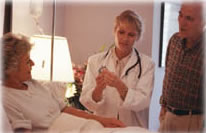|
Herpes Simplex - Causes, Symptoms and Treatment
Definition
Herpes viruses cause cytolytic infections. Therefore, pathologic changes are due to cell necrosis as well as inflammatory changes. Fluid accumulates between the dermis and the epidermal skin layers and causes vesicle formation. The fluid then is absorbed, scabs are formed, and healing is completed without evidence of scarring. Shallow ulcers form after the vesicles rupture on mucous membranes. The herpes simplex virus causes blisters and sores around the mouth, nose, genitals, and buttocks, but they may occur almost anywhere on the skin.HSV infections can be very annoying because they may reappear periodically. The sores may be painful and unsightly. For chronically ill people and newborn babies, the viral infection can be serious, but rarely fatal.
These are of two types:
- Herpes Simplex Virus Type 1
- Herpes Simplex Virus Type 2
Causes
- Two types of herpes simplex virus infections can cause genital herpes. HSV type 1 (HSV-1) is the type that usually causes cold sores or fever blisters around your mouth, though it can be spread to your genital area during oral sex.
- HSV type 2 (HSV-2) is the type that commonly causes genital herpes. The virus spreads through sexual contact and skin-to-skin contact. HSV-2 is very common and highly contagious whether you have an open sore or not.
- A finger infection, called herpetic whitlow, is another form of herpes infection. It usually affects health care providers who are exposed to oral secretions during procedures.
- Sometimes, young children contract the disease.
- It may also be transmitted to a newborn during vaginal delivery in mothers infected with herpes viruses, particularly if the mother has active infection at the time.
Symptoms
- In starting there occur infection and a fluid accumulation at the infection site. Then there occurs small, grouped blisters.
- The blisters may dry out and heal rapidly without scarring with 7 to 10 days. Blisters in moist areas heal more slowly than others.
- The lesions may sometimes itch, but itching decreases as lesions heal.
- There may be genital lesions in both males and females and may be preceded by burning or tingling sensation
- Light grade fever may present in the starting stage of disease.
- There may be painful urination, and swollen and tender lymph glands in the groin.
Treatment
- Keep the infected area as clean and dry as possible.
- Warm showers should be taken in order to cleanse the infected area.
- There is treatment available for acute outbreaks that involve the use of anti-viral drugs such as Acyclovir, Valaclovir or Famcyclovir.
- Long-term drug therapy may be helpful for individuals who suffer frequent recurrent outbreaks. These treatments will reduce outbreaks by 85 percent and reduces viral shedding by more than 90 percent.
- Any pain caused by a cold sore can be eased by applying a cold compress of witch hazel to the affected area or by taking paracetamol.
- Antiviral drugs will stop the herpes simplex virus multiplying once it reaches the skin or mucous membranes but cannot eradicate the virus from its resting stage within the nerve cells.
|
|





